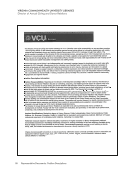7 of those said that it supported the library financially, while 14 (35%) said their university’s alumni association supported the library through advocacy. Twenty-seven (45%) reported their library has a student advisory board although none reported that board supports the library financially, 15 (56%) indicated they support the library through advocacy. Fifteen respondents (25%) reported that a group other than those listed above exists at their institution: these include a librarian emeriti board, faculty advisory board, special collections advisory board, and alumni outreach group. Of those, five (33%) support their library both financially and through advocacy, while seven (47%) support them through advocacy only.At the 29 libraries that reported having a development board, the average size of the board is 36.53 members. The fewest number of members is 1 the largest number of members is 45. Most reported having a chair or president and members. A small handful indicated they had a vice chair and still others had chairs of subcommittees. Twenty-six (84%) responded that the processes, terms, obligations, and other conditions of their development committees are comparable to other schools and units on campus. Only five (16%) reported that they were not, and one didn’t know. Thirty-eight of 49 respondents said their development program is engaged in activities that could be characterized as “friend-raising.” Thirty of those provided a long list of great ideas for engaging potential donors, including programs and events (large and small), dinners, exhibitions, special events, lectures and author readings, presentations, tours, open houses and community engagement, and holiday parties. Many of these events and programs target community patrons and local alumni. In addition, several libraries note that their development officer is a member of local organizations like Rotary Club for the purpose of friend-raising. Donor Communications For the purpose of this survey, donor communications include print and electronic communications used to solicit or steward potential donors. They may include library stories, statistics, and other measures used to convey library value and success. While most of the libraries are soliciting and stewarding their donors in both print and electronic format, the preferred means still appears to be print. The way in which libraries otherwise communicate with potential donors seems to vary depending on the content. Thirty-two libraries use both print and electronic means to solicit potential donors, Fifteen use print only, and three use electronic only. In sending stewardship letters to their donors, 21 libraries use both print and electronic communication to steward their donors, 29 use print only, and none use electronic only. Libraries are much more likely to send a print version than an electronic version of their magazine, although they are more likely to send an electronic version of their newsletter than a print version. Interestingly, more libraries report sharing newsletters than magazines. Forty-five respondents (85%) said they send informal communication, like birthday cards, to donors. Twenty-five libraries use print exclusively, 17 use both print and electronic, and three use electronic exclusively. Twenty-three libraries send out other types of donor communications. Of those, 17 use both print and electronic communication, and three use either print or electronic exclusively. These types of communications include proposals, annual reports, event invitations, brochures and pamphlets, endowment impact reports, blogs, and social media (like Facebook and Twitter posts). Among the quantitative measures of library outcomes and performance used in these communications, beyond metrics or statistics like gate counts, many libraries share fundraising totals (like number of donors, dollars raised). More importantly, some libraries are attempting to show how those dollars are impacting student success. Several are very wisely using analytics to track the effectiveness of their electronic communications with potential donors. If available, some libraries would try to show the impact of their collections on research and the impact on student success. There also seems to be an interest in measuring the impact library collections have on university departments as a way to demonstrate value.



















































































































































































